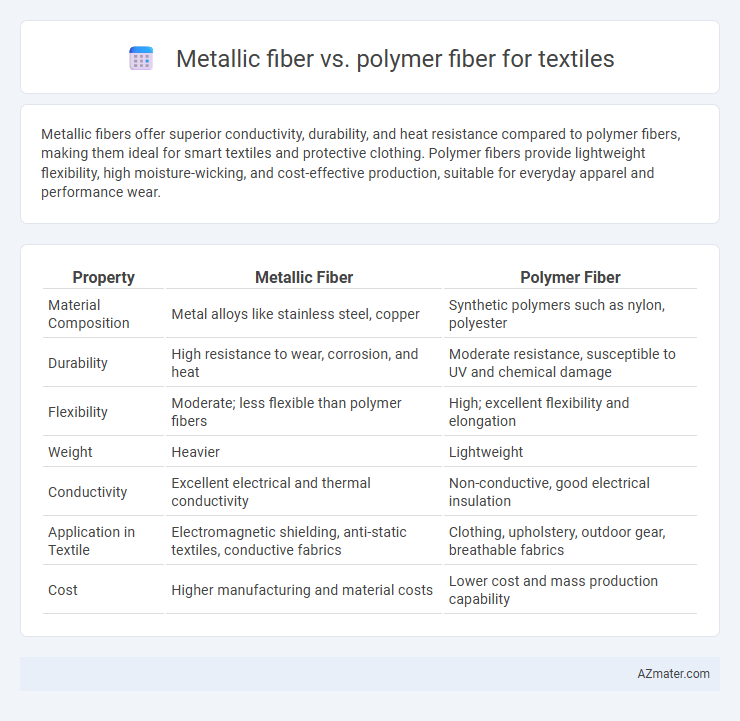Metallic fibers offer superior conductivity, durability, and heat resistance compared to polymer fibers, making them ideal for smart textiles and protective clothing. Polymer fibers provide lightweight flexibility, high moisture-wicking, and cost-effective production, suitable for everyday apparel and performance wear.
Table of Comparison
| Property | Metallic Fiber | Polymer Fiber |
|---|---|---|
| Material Composition | Metal alloys like stainless steel, copper | Synthetic polymers such as nylon, polyester |
| Durability | High resistance to wear, corrosion, and heat | Moderate resistance, susceptible to UV and chemical damage |
| Flexibility | Moderate; less flexible than polymer fibers | High; excellent flexibility and elongation |
| Weight | Heavier | Lightweight |
| Conductivity | Excellent electrical and thermal conductivity | Non-conductive, good electrical insulation |
| Application in Textile | Electromagnetic shielding, anti-static textiles, conductive fabrics | Clothing, upholstery, outdoor gear, breathable fabrics |
| Cost | Higher manufacturing and material costs | Lower cost and mass production capability |
Introduction to Textile Fibers
Metallic fibers, composed of pure metal or metal-coated filaments, offer superior conductivity, durability, and aesthetic appeal in textiles, contrasting polymer fibers like polyester and nylon that provide flexibility, lightweight properties, and moisture-wicking capabilities. Textile fibers are fundamental components defined by their origin, physical properties, and performance, impacting fabric strength, texture, and function. The choice between metallic and polymer fibers depends on application requirements, balancing conductivity and strength against comfort and elasticity.
Overview of Metallic Fibers
Metallic fibers, composed primarily of stainless steel, aluminum, or copper, offer exceptional conductivity, durability, and resistance to heat and corrosion, making them ideal for technical and protective textiles. These fibers enhance electromagnetic shielding and antistatic properties in fabrics, outperforming conventional polymer fibers in applications demanding high performance and longevity. Unlike polymer fibers, metallic fibers provide superior structural strength and thermal stability, crucial for specialized industrial and medical textile products.
Overview of Polymer Fibers
Polymer fibers, commonly used in textile manufacturing, offer exceptional flexibility, durability, and lightweight properties compared to metallic fibers. These fibers consist of long-chain synthetic molecules such as nylon, polyester, and polypropylene, which contribute to high tensile strength and resistance to moisture and chemicals. Their cost-effectiveness and ease of dyeing make polymer fibers ideal for a wide range of apparel, industrial textiles, and technical fabric applications.
Physical Properties: Metallic vs Polymer Fibers
Metallic fibers exhibit high tensile strength, excellent conductivity, and superior thermal resistance compared to polymer fibers, which are generally lighter and more flexible with lower density. Polymer fibers such as polyester and nylon offer greater elasticity and moisture absorption, providing enhanced comfort and durability in textile applications. The choice between metallic and polymer fibers depends on the required balance of rigidity, conductivity, and wearability in specific textile products.
Performance and Functionality Comparison
Metallic fibers in textiles offer superior conductivity, antimicrobial properties, and enhanced durability compared to polymer fibers, making them ideal for smart fabrics and protective clothing. Polymer fibers excel in flexibility, lightweight comfort, and moisture-wicking capabilities, which are essential for activewear and everyday apparel. Performance-wise, metallic fibers provide advanced functionalities like electromagnetic shielding, while polymer fibers deliver better elasticity and breathability for improved wearer comfort.
Durability and Maintenance Factors
Metallic fibers offer superior durability in textiles due to their resistance to abrasion, heat, and chemical exposure, making them ideal for industrial and high-performance applications. Polymer fibers, such as polyester and nylon, provide enhanced flexibility and moisture resistance but may degrade faster under UV exposure and high temperatures. Maintenance of metallic fiber textiles generally requires careful handling to prevent tarnishing, while polymer fibers are easier to clean and maintain with standard laundering processes.
Applications in the Textile Industry
Metallic fibers offer superior conductivity and durability, making them ideal for electromagnetic shielding, smart textiles, and wearable technology applications in the textile industry. Polymer fibers excel in flexibility, lightweight properties, and moisture management, widely used in sportswear, insulation, and protective clothing. The choice between metallic and polymer fibers depends on the specific functional requirements such as conductivity, strength, and comfort in textile product development.
Cost and Sustainability Considerations
Metallic fibers, typically made from stainless steel or aluminum, tend to be more expensive than polymer fibers like polyester or nylon due to higher raw material and processing costs. Polymer fibers offer better sustainability profiles, as they are lightweight, recyclable, and often produced from renewable resources or recycled plastics, reducing environmental impact. The energy-intensive production and limited recyclability of metallic fibers pose challenges for eco-friendly textile manufacturing compared to polymer alternatives.
Innovations and Future Trends
Metallic fibers offer enhanced conductivity, durability, and antimicrobial properties, making them ideal for advanced smart textiles and wearable electronics. Polymer fibers, especially bio-based and biodegradable variants, provide flexibility and sustainability for eco-friendly fashion and medical applications. Future trends emphasize hybrid fiber technologies combining metallic and polymer elements to optimize performance, comfort, and environmental impact in next-generation textile innovations.
Conclusion: Choosing the Right Fiber for Your Needs
Metallic fibers offer superior conductivity, durability, and a unique aesthetic for textiles requiring high-performance or decorative applications, while polymer fibers excel in flexibility, moisture-wicking, and cost-effectiveness for everyday wear and technical fabrics. The choice between metallic and polymer fibers depends on specific needs such as electrical properties, comfort, and budget constraints. For high-tech or fashion-forward textiles, metallic fibers provide distinct advantages, whereas polymer fibers remain ideal for versatile, lightweight, and breathable garment construction.

Infographic: Metallic fiber vs Polymer fiber for Textile
 azmater.com
azmater.com